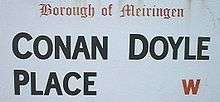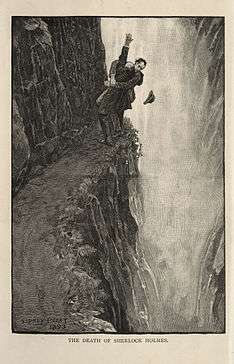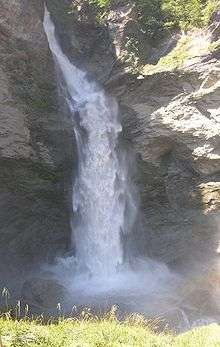The Final Problem
| "The Final Problem" | |
|---|---|
|
| |
| Author | Arthur Conan Doyle |
| Country | United Kingdom |
| Language | English |
| Series | The Memoirs of Sherlock Holmes |
| Genre(s) | Crime novel |
| Published in | Strand Magazine |
| Media type | |
| Publication date | December 1893 |
| Preceded by | "The Naval Treaty" |
"The Final Problem" is a short story by British writer Arthur Conan Doyle featuring his detective character Sherlock Holmes. It was first published in Strand Magazine in December 1893. It appears in book form as part of the collection The Memoirs of Sherlock Holmes. Conan Doyle later ranked "The Final Problem" fourth on his personal list of the twelve best Holmes stories.[1]
Plot summary
This story, set in 1891, introduces Holmes's greatest opponent, the criminal mastermind Professor James Moriarty.
Holmes arrives at Dr. John Watson's residence one evening in a somewhat agitated state and with grazed and bleeding knuckles. Much to Watson's surprise, he had apparently escaped three separate murder attempts that day after a visit from Professor Moriarty, who warned Holmes to withdraw from his pursuit of justice against him to avoid any regrettable outcome. First, just as he was turning a street corner, a cab suddenly rushed towards him and Holmes just managed to leap out of the way in time. Second, while Holmes was walking along the street, a brick fell from the roof of a house, just missing the detective. He then called the police to search the whole area but could not prove that it was anything other than an accident. Finally, on his way to Watson's house, he was attacked by a thug armed with a cosh. Holmes managed to overcome his assailant and handed him to the police but admitted that there was virtually no hope of proving that the man was in the employ of the criminal mastermind.
Holmes has been tracking Moriarty and his agents for months and is on the brink of snaring them all and delivering them to the dock. Moriarty is the criminal genius behind a highly organized and extremely secret criminal force and Holmes will consider it the crowning achievement of his career if only he can defeat Moriarty. Moriarty is out to thwart Holmes's plans and is well capable of doing so, for he is, as Holmes admits, the great detective's only intellectual equal.
Holmes asks Watson to come to the continent with him, giving him unusual instructions designed to hide his tracks to Victoria station. Holmes is not quite sure where they will go, which seems rather odd to Watson. Holmes, certain that he has been followed to his friend's house, then makes off by climbing over the back wall in the garden. The next day Watson follows Holmes's instructions to the letter and finds himself waiting in the reserved first class coach for his friend, but only an elderly Italian priest is there. The cleric soon makes it apparent that he is in fact, Holmes in disguise.
As the train pulls out of Victoria, Holmes spots Moriarty on the platform, apparently trying to get someone to stop the train. Holmes is forced to take action as Moriarty has obviously tracked Watson, despite extraordinary precautions. He and Watson alight at Canterbury, making a change to their planned route. As they are waiting for another train to Newhaven a special one-coach train roars through Canterbury, as Holmes suspected it would. It contains the professor, who has hired the train in an effort to overtake Holmes. Holmes and Watson are forced to hide behind luggage.
Having made their way to Strasbourg via Brussels, the following Monday Holmes receives a message that most of Moriarty's gang have been arrested in England and recommends Watson return there now, as the detective will likely prove to be a very dangerous companion. Watson, however, decides to stay with his friend. Moriarty himself has slipped out of the grasp of the English police and is obviously with them on the continent.
Holmes and Watson's journey takes them to Switzerland where they stay at Meiringen. From there they fatefully decide to take a walk which will include a visit to Reichenbach Falls, a local natural wonder. Once there, a boy appears and hands Watson a note, saying that there is a sick Englishwoman back at the hotel who wants an English doctor. Holmes realises at once it is a hoax although he does not say so. Watson goes to see about the patient, leaving Holmes by himself.
Upon returning to the Englischer Hof, Watson finds that the innkeeper has no knowledge of any sick Englishwoman. Realizing at last that he has been deceived, he rushes back to Reichenbach Falls but finds no one there, although he does see two sets of footprints going out onto the muddy dead end path with none returning. There is also a note from Holmes, explaining that he knew the report Watson was given to be a hoax and that he is about to fight Moriarty, who has graciously given him enough time to pen this last letter. Watson sees that towards the end of the path there are signs that a violent struggle has taken place and there are no returning footprints. It is all too clear Holmes and Moriarty have both fallen to their deaths down the gorge while locked in mortal combat. Saddened, Dr. Watson returns to England. The Moriarty gang are all convicted on the strength of evidence secured by Holmes. Watson ends his narrative by saying that Sherlock Holmes was the best and the wisest man he had ever known.
Themes and circumstances of writing
"The Final Problem" was intended to be exactly what its name says. Conan Doyle meant to stop writing about his famous detective after this short story; he felt the Sherlock Holmes stories were distracting him from more serious literary efforts and that "killing" Holmes off was the only way of getting his career back on track. "I must save my mind for better things," he wrote to his mother, "even if it means I must bury my pocketbook with him."
Conan Doyle sought to sweeten the pill by letting Holmes go in a blaze of glory, having rid the world of a criminal so powerful and dangerous that any further task would be trivial in comparison (Holmes says as much in the story).
In 1893, Conan Doyle and his wife toured Switzerland[2] and discovered the village of Meiringen in the Bernese Alps.[2] This experience fired Conan Doyle's imagination.
"In 1893 he wrote in his diary, which still exists, that he wanted to kill Sherlock Holmes at the Reichenbach Falls," says Jürg Musfeld, director of the Park Hotel du Sauvage, where Conan Doyle is believed to have stayed during his visit to the village.[2]
But this device failed in its purpose and pressure from fans eventually persuaded Doyle to bring Holmes back, writing The Hound of the Baskervilles (set before "The Final Problem") and reviving him in "The Adventure of the Empty House". There were enough holes in eyewitness accounts to allow Conan Doyle to plausibly resurrect Holmes; only the few free surviving members of Moriarty's organisation and Holmes' brother Mycroft (who appears briefly in this story) know that Sherlock Holmes is still alive, having won the struggle at Reichenbach Falls and sent Moriarty to his doom—though nearly meeting his own at the hands of Moriarty's henchmen.[3]
Adaptations
William Gillette's 1899 stage play Sherlock Holmes is based on several stories, among them "The Final Problem." Films released in 1916 (starring Gillette as Holmes) and 1922 (starring John Barrymore), both titled Sherlock Holmes, were based on the play, as well as a 1938 Mercury Theatre on the Air radio adaptation titled The Immortal Sherlock Holmes, starring Orson Welles as Holmes, although in none of these retellings does Holmes die (and indeed in the two film versions he marries).[4]
The 1931 film The Sleeping Cardinal is based in part on "The Adventure of the Empty House" and "The Final Problem." The scene from "The Final Problem" in which Moriarty confronts Holmes at Baker Street and attempts to persuade Holmes to stop his investigations is used in the films The Triumph of Sherlock Holmes (1935) and The Woman in Green (1945). A variation on this scene is also used in "The Great Game," the third episode of the 2010 BBC television series Sherlock.[5]
In the 1939 film series starring Basil Rathbone as Holmes and Nigel Bruce as Watson, a number of films borrow elements from "The Final Problem". Most noticeable of these elements is the methods of killing Moriarty off; in The Adventures of Sherlock Holmes, Sherlock Holmes and the Secret Weapon and The Woman in Green Moriarty is seen in all three films falling a great height to his death. The Woman in Green contains a variation on the conversation between Holmes and Moriarty in Baker Street, as well as the idea of Moriarty manipulating Watson out of the way by hoaxing an injured Englishwoman who requires his treating.
The story was later adapted for radio by John Kier Cross; it was broadcast on 17 April 1955 and starred John Gielgud as Holmes, Ralph Richardson as Dr. Watson, and Orson Welles as Professor Moriarty. BBC Radio also broadcast an adaptation of "The Final Problem" on 4 November 1992.
In 1975, DC Comics published Sherlock Holmes #1, a comic which adapted "The Adventure of the Empty House" and "The Final Problem".[6] It was intended to be an ongoing series, but future issues were cancelled due to low sales.
The 1979 Soviet series The Adventures of Sherlock Holmes and Dr. Watson adapted "The Final Problem" as "The Deadly Fight" and "The Adventure in the Empty House" as "Hunt for the Tiger."
In the 1985 television series Sherlock Holmes starring Jeremy Brett, the story begins with the theft of the Mona Lisa, masterminded by Moriarty in order to sell prepared fakes to collectors. Holmes recovers the original painting just before Moriarty makes a sale to a "Mr. Morgan". Holmes's interference with his plans convinces Moriarty that the detective must be eliminated, and Holmes is subsequently presumed to have died in a tumble down Reichenbach Falls. This was the last episode to star David Burke as Dr. Watson. Burke was replaced by Edward Hardwicke until the end of the show's run, starting with the adaptation of "The Empty House" which acted as the first episode of The Return of Sherlock Holmes.
The first episode of the 1999 animated television series Sherlock Holmes in the 22nd Century begins with the climax of "The Final Problem".
The 1999 comic series The League of Extraordinary Gentlemen, Volume One by Alan Moore and Kevin O'Neill briefly adapts "The Final Problem" in issue #5 and shows Holmes triumphing over Moriarty and climbing the cliff, although Moriarty survives as well. The film adaptation references these events, but does not show them; the novelization copies the event almost verbatim as it appears in the graphic novel.
The 2011 film Sherlock Holmes: A Game of Shadows is based in part on "The Final Problem".[7] Like the story, it ends with Holmes and Moriarty plummeting into the falls, and Watson is shown writing the final sentences of "The Final Problem" on his typewriter. However, in the film, the characters are attending a European Peace Conference held near the falls which Moriarty seeks to sabotage, and the two plunge down from a balcony overlooking the falls rather than from the ledge of the original story. Holmes is also shown falling over the edge with Moriarty rather than simply being assumed to have fallen, being too injured to defeat Moriarty in a straight fight but knowing that Moriarty will go after Watson if he lives. While Holmes is shown to have survived, having used his brother's oxygen inhaler to survive the water at the bottom of the falls, Moriarty's fate is less certain.
The story is also the basis of "The Reichenbach Fall", the third episode of the second season of the TV series Sherlock, which first aired on 15 January 2012 and shows Holmes falling from the roof of a hospital, supposedly leading to his death.[8][9] Throughout a confrontation between Sherlock and Jim Moriarty in Baker Street, Moriarty repeatedly utters the phrase "the final problem".
In Kim Newman's 2011 book Professor Moriarty: The Hound of the D'Urbervilles, told from the point of view of Col. Sebastian Moran, the story "The Problem of the Final Adventure" reveals that Professor Moriarty's plan had been to lead Sherlock Holmes to destroy Moriarty's rival, the German criminal Doctor Mabuse.
The series finale of the American medical drama House—which was inspired by the Sherlock Holmes stories—sees Dr. Gregory House fake his own death, in an ode to "The Final Problem".[10]
The 2013 Russian series Sherlock Holmes adapted "The Final Problem" as "Holmes' Last Case".
The special episode of Sherlock, The Abominable Bride, which was broadcast on 1 January 2016, featured a re-creation of the showdown between Sherlock and Moriarty set in Victorian times, as depicted in the book.
Memorials at Meiringen and the falls

Inhabitants of Meiringen are still grateful to Doyle and Holmes for ensuring the enduring worldwide fame of their falls and considerably promoting tourism to the town.
A museum dedicated to Holmes is housed in the basement of the English Church, located in what has now been named Conan Doyle Place.[2]

At the funicular station near the falls, there is a memorial plate to "the most famous detective in the world".[2]
The actual ledge from which Moriarty fell is on the other side of the falls. It is accessible by climbing the path to the top of the falls, crossing the bridge, and following the trail down the hill. The ledge is marked by a plaque written in English, German, and French. The English inscription reads "At this fearful place, Sherlock Holmes vanquished Professor Moriarty, on 4 May 1891." It is also marked by a large cross so as to be visible from the viewing platform.
Fans who call themselves "pilgrims"[11] travel to Meiringen dressed as characters, both major and minor, from the Holmes stories.[11] There, they take part in a reenactment of the events of "The Final Problem" organised by The Sherlock Holmes Society of London.[11]
References
- ↑ Doyle, Arthur Conan; Giddings, Robert (2009), Favourite Sherlock Holmes stories, Atlantic, ISBN 978-1-84354-910-9
- 1 2 3 4 5 "Sherlock Holmes success no mystery". swissinfo.ch. 19 May 2006. Retrieved 5 November 2012.
- ↑ Baring-Gould, William S., The Annotated Sherlock Holmes. New York: Clarkson N. Potter, Inc., 1967, pp. 320-328.
- ↑ "The Mercury Theatre on the Air". Mercurytheatre.info. Retrieved 2012-03-28.
- ↑ Mark Gatiss, Benedict Cumberbatch and Martin Freeman. DVD audio commentary for Sherlock: "The Great Game".
- ↑ "DC Comics: Sherlock Holmes #1". A Study in Sherlock. 2006-05-28. Retrieved 2012-03-28.
- ↑ Tilly, Chris (2011-02-22). "Sherlock Holmes: A Game of Shadows Preview - Movies Preview at IGN". Movies.ign.com. Retrieved 2012-03-28.
- ↑ Singer, Leigh (10 April 2011). "Kapow! 11: Ideal Holmes: Mark Gatiss on the new series of Sherlock and Doctor Who". IGN.com. Retrieved 2011-04-26.
- ↑ "BBC One's BAFTA-nominated Sherlock begins filming second series". BBC Press Office. 2011-05-16. Retrieved 2011-05-16.
- ↑ Sepinwall, Alan (22 May 2012). "Series Finale Review: 'House' - "Everybody Dies' Keep Me in Your Heart for a While". HitFix.com. Retrieved 31 December 2014.
- 1 2 3 "The curious case of the Sherlock Holmes pilgrims". Prospect. 31 October 2012. Retrieved 5 November 2012.
External links
 Works related to The Final Problem at Wikisource
Works related to The Final Problem at Wikisource Media related to The Adventure of the Final Problem at Wikimedia Commons
Media related to The Adventure of the Final Problem at Wikimedia Commons

